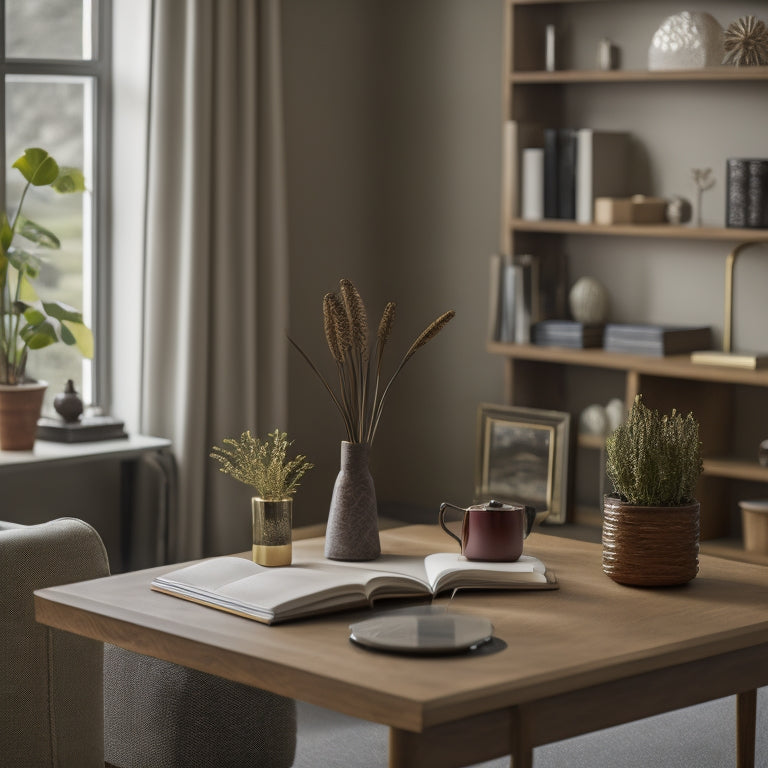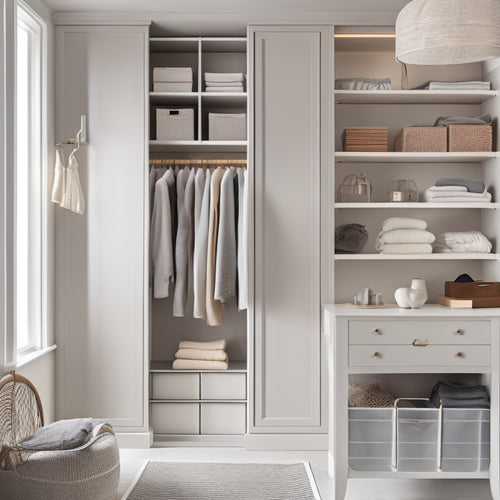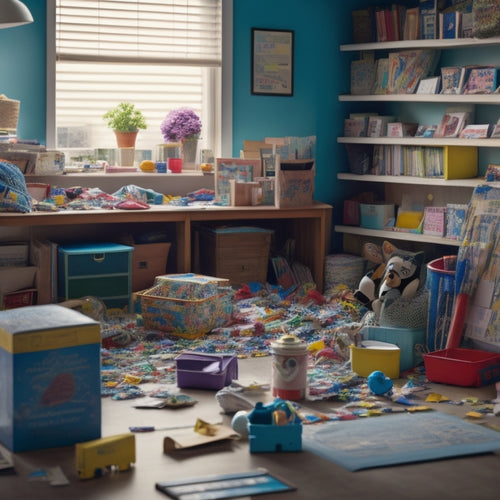
7 Best Decluttering Hacks for Busy Homeowners
Share
You can tackle clutter in manageable chunks, even with a packed schedule. Start by decluttering one area at a time, setting a timer to stay focused. Establish a morning routine to prioritize tasks and set intentions for the day. Sort items efficiently by categorizing, grouping, and creating subcategories. Use storage containers wisely by assigning categories and implementing a labeling system. Designate a 'launching pad' to keep daily essentials organized, and practice the 'one in' rule to maintain balance. Finally, schedule regular maintenance to prevent clutter buildup. By implementing these 7 decluttering hacks, you'll be well on your way to a more organized, stress-free life, and uncover even more ways to optimize your space.
Key Takeaways
• Declutter one area at a time to maintain focus and avoid feeling overwhelmed, setting a timer to boost productivity.
• Establish a mindful morning routine to prioritize decluttering tasks and set intentions for the day, avoiding screens for an energy boost.
• Implement the 'one in, one out' rule to maintain balance and prevent clutter buildup, making deliberate decisions on what to keep or discard.
• Use storage containers efficiently by assigning specific categories, labeling, and storing them effectively, considering frequency of use and accessibility.
• Set aside time for daily, weekly, and seasonal reviews to maintain a clutter-free living space, adjusting and getting rid of unneeded items as needed.
Declutter One Area at Time
To tackle the challenging task of decluttering, focus your energy on one area at a time, allowing you to concentrate your efforts and make tangible progress. This approach helps you avoid feeling overwhelmed and enables you to see the results of your hard work.
Identify specific focus areas, such as your kitchen countertop, bedroom closet, or home office desk, and dedicate a decluttering session to each one. Set a timer for a specific amount of time, say 30 minutes, and challenge yourself to clear out as much clutter as possible during that session.
By focusing on one area at a time, you'll be able to sort items into categories, such as keep, donate, and discard, and make intentional decisions about what stays and what goes. As you complete each decluttering session, take a moment to admire your handiwork and feel a sense of accomplishment.
This momentum will carry you through to the next focus area, helping you stay motivated and committed to your decluttering goals.
Create a Morning Routine
Your morning routine sets the tone for a clutter-free day, and by incorporating a few simple habits, you can establish a sense of control and momentum that carries over into the rest of your daily activities.
Start by creating a Mindful Morning, where you dedicate 10-15 minutes to meditation, deep breathing, or simply enjoying a cup of coffee in peace. This quiet time helps clear your mind and sets intentions for the day ahead.
Next, prioritize tasks that give you an Energy Boost, such as a short workout, stretching, or a quick tidy of your living room. This morning burst of energy will motivate you to tackle more significant decluttering tasks later in the day.
Try to avoid screens during this time, as the blue light can disrupt your focus and make you feel sluggish.
Sort Items Into Categories
Now that you've established a morning routine, it's time to tackle the task of sorting items into categories.
You'll start by separating items into three piles: keep, donate/sell, and discard.
Purge the Easy Stuff
Five minutes a day is all it takes to sort items into categories, making it manageable to purge the easy stuff that's cluttering your space. By dedicating a small chunk of time each day, you'll be amazed at how quickly you can tackle speed clutter and achieve those quick wins that'll motivate you to keep going.
To get started, gather some boxes or bins and label them as "Keep," "Donate/Sell," and "Toss." Then, grab a timer and set it for five minutes. Focus on one area, such as your dresser or bookshelf, and start sorting items into their respective categories.
Here's a breakdown of what you can accomplish in just five minutes:
| Category | Action | Result |
|---|---|---|
| Keep | Put away items that are useful or sentimental | Clutter-free surfaces |
| Donate/Sell | Bag up items that are still in good condition | Extra cash or a decluttered space |
| Toss | Throw away items that are broken or useless | Reduced waste and clutter |
| Paper Clutter | Sort and recycle papers, bills, and receipts | Organized paperwork |
| Miscellaneous | Handle items that don't fit into other categories | A sense of accomplishment |
Handle the Rest
With your easy-to-purge items out of the way, you're ready to tackle the remaining clutter by categorizing items into groups that require more thought and decision-making. This is where the real decluttering work begins. Start by grouping similar items together, such as clothes, books, or kitchen items.
Within each group, create subcategories, like 'keep,' 'donate,' 'sell,' and 'recycle.' This will help you make intentional decisions about what to do with each item.
Set a timer for a specific block of time, say 30 minutes, and focus on one category at a time. This time-blocking technique will help you stay focused and avoid feeling overwhelmed. Don't be afraid to delegate tasks to family members or roommates to speed up the process.
Assign each person a category to sort through, and work together to make decisions. By categorizing and prioritizing your remaining clutter, you'll be able to make progress quickly and efficiently.
Use Storage Containers Wisely
You can maximize your storage space by assigning a specific category or item to each container, making it easy to find what you need when you need it. This approach helps you maintain organization and avoid clutter buildup.
To take it a step further, implement a labeling system that clearly indicates what's inside each container. This can be as simple as using labels or stickers with the category or item name, or as detailed as creating a color-coding system.
When it comes to container placement, think vertically and horizontally. Store containers in areas that make sense for your daily routine, such as under beds, in closets, or on high shelves. Consider the frequency of use and store items that you use daily in easily accessible locations.
Designate a "Launching Pad"
To maintain a clutter-free home, you need a designated spot to corral your daily essentials. This 'launching pad' serves as a daily drop zone where you can place your keys, wallet, and other items that tend to get lost in the chaos.
Daily Drop Zone
Designate a specific area, such as a tray or bin near the entrance, as your daily drop zone, where you can deposit keys, wallets, and other essentials, creating a centralized 'launching pad' that streamlines your daily routine. This entry station or landing strip helps you stay organized and saves time by keeping frequently used items in one place.
Here's a breakdown of what you can store in your daily drop zone:
| Item | Benefits |
|---|---|
| Keys | No more searching for lost keys |
| Wallets | Always know where your wallet is |
| Phones | Designated spot for charging |
| Bags | Keep backpacks, purses, or lunch bags organized |
| Centralized spot for sorting mail |
Morning Launch Site
Transform a cluttered morning routine into a seamless launch by setting up a morning launch site, a strategic spot near your daily drop zone where you can prep everything you need for the day ahead. This designated area will become your Launch Station, where you'll gather your essentials and mentally prepare for the day.
A well-organized morning launch site helps you cultivate a positive Morning Mindset, setting the tone for a productive day.
To create your morning launch site, identify a convenient spot, such as a corner of your entryway or a section of your kitchen counter. Clear the area of clutter and designate a specific spot for each item, like your keys, wallet, and bag. Consider adding a small tray or dish for corralling small items like coins or jewelry.
This thoughtful setup will save you time and reduce morning stress. With your morning launch site in place, you'll be able to grab what you need quickly and head out the door feeling more in control and prepared to tackle the day.
Practice the "One In" Rule
By adopting the 'one in' rule, you'll find that every new possession entering your home sparks a deliberate decision to let go of an old one, maintaining a balanced scale of possessions and preventing clutter from building up over time. This simple yet effective rule helps you establish personal boundaries and rewire your shopping mindset.
When you bring something new into your home, you must remove or donate an existing item to make space for it. This forces you to evaluate the value and usefulness of each item, ensuring that only essential and meaningful possessions remain.
By practicing the 'one in' rule, you'll develop a more mindful approach to consumption, thinking twice before making impulsive purchases. You'll also reduce waste, save money, and enjoy a more organized, clutter-free living space.
Schedule Regular Maintenance
Set aside a specific time each week to maintain your newly decluttered space, ensuring that clutter doesn't slowly creep back in and undo your hard work. This regular maintenance is essential to preventing clutter from building up again. By dedicating a few minutes each week, you'll create a habit that will serve you well in the long run.
To make the most of your maintenance sessions, focus on the following:
-
Daily tidying: Take a few minutes each day to quickly pick up items that are out of place and put them back in their designated spot.
-
Weekly reviews: Set aside 10-15 minutes each week to review your space and make any necessary adjustments. This is a great opportunity to get rid of items that are no longer needed or useful.
-
Seasonal reviews: Schedule deeper cleaning and organization sessions on a seasonal basis to tackle areas that need more attention, such as your closet or garage. This will help you stay on top of clutter and keep your space organized throughout the year.
Frequently Asked Questions
How Do I Stay Motivated to Declutter When It Feels Overwhelming?
When decluttering feels overwhelming, you'll reach breakthrough moments by setting achievable goals and enlisting accountability partners to keep you on track, providing moral support and celebrating small victories to maintain your motivation.
Can I Declutter With Kids and Still Keep Them From Messing It Up?
You're maneuvering through a minefield, trying to declutter with tiny tornados running around! Set up kid-friendly storage zones, and employ distraction techniques like 'decluttering dance parties' to keep them occupied while you tidy up.
What if I'm Attached to Sentimental Items and Can't Let Go?
You're holding onto sentimental items due to emotional ties, but it's okay! Create a Memory Box for treasured keepsakes, and set a limit on what you keep, allowing you to cherish memories without clutter overwhelming your space.
Is It Better to Declutter During the Day or at Night?
When deciding when to declutter, you're likely wondering if it's better to tackle it during your morning routine or as a nighttime ritual. You'll find that decluttering during the day, when you're most focused, yields better results.
How Long Does It Take to See Progress in Decluttering Efforts?
"You'll be waiting an eternity for results if you don't set a decluttering timeline! Expect to see progress benchmarks in 2-4 weeks, with significant changes in 8-12 weeks, and a transformed space in 6 months, if you stay committed to your decluttering routine."
Related Posts
-

Mastering Small Closet Organization: Proven Strategies Unlocked
You're about to reveal the secret to transforming your small closet into a functional haven, where every item has its...
-

What's the Best Home Organization System for ADHD?
You need a home organization system that acknowledges your unique brain chemistry and works with your ADHD, not again...

